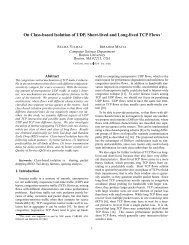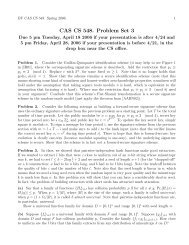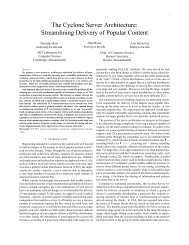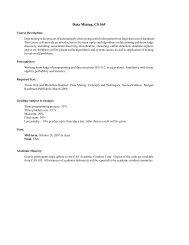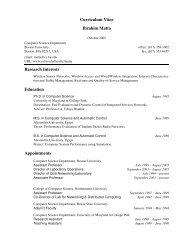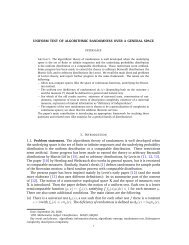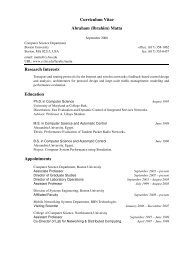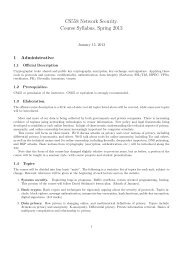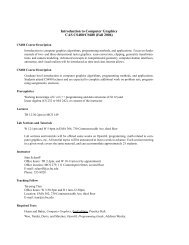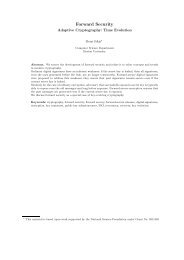Hashing Methods for Temporal Data - Computer Science - Boston ...
Hashing Methods for Temporal Data - Computer Science - Boston ...
Hashing Methods for Temporal Data - Computer Science - Boston ...
Create successful ePaper yourself
Turn your PDF publications into a flip-book with our unique Google optimized e-Paper software.
8 IEEE TRANSACTIONS ON KNOWLEDGE AND DATA ENGINEERING, VOL. XXX, NO. XX, XXXXXXX 2001<br />
There are two differences between the evolving-list and<br />
the evolving-set approaches. First,updating using the<br />
Snapshot Index remains constant,while,in the evolving<br />
list,the whole current list may have to be searched <strong>for</strong><br />
deleting an oid. Second,reconstruction in the evolving-list<br />
starts from the top of the list pages while,in the evolvingset,reconstruction<br />
starts from the last page of the bucket.<br />
This may affect the search <strong>for</strong> a given oid depending<br />
whether it has been placed near the top or near the end of<br />
the bucket.<br />
4 PERFORMANCE ANALYSIS<br />
For the Partially Persistent Linear <strong>Hashing</strong>,we implemented<br />
the set-evolution PPLH-s) and the list-evolution<br />
PPLH-l) approaches,using controlled splits. Both are<br />
compared against Linear <strong>Hashing</strong> in particular, Atemporal<br />
linear hashing,which is discussed below),the MVBT,and<br />
two R*-tree implementations R i which stores intervals<br />
in a 2-dimensional space and R p which stores points in<br />
a 3-dimensional space). The partial persistence methodology<br />
is applicable to other hashing schemes as well. We<br />
implemented Partially Persistent Extendible <strong>Hashing</strong> using<br />
the set-evolution PPEH-s) and uncontrolled splits and<br />
compared it with PPLH-s. Implementation details and the<br />
experimental setup are described in Section 5.1,the data<br />
workloads in Section 5.2,and our findings in Section 5.3.<br />
4.1 Method ImplementationÐExperimental Setup<br />
We set the size of a page to hold 25 object records B ˆ 25).<br />
In addition to the object's oid and lifespan,the record<br />
contains a pointer to the actual object which may have<br />
additional attributes).<br />
We first discuss the Atemporal linear hashing ALH). It<br />
should be clarified that ALH is not the ephemeral linear<br />
hashing whose evolution the partially persistent linear<br />
hashing observes and stores. Rather,it is a conventional<br />
linear hashing scheme that treats time as just another<br />
attribute. This scheme simply maps objects to buckets using<br />
the object oids. Consequently,it ªseesº the different<br />
lifespans of the same oid as copies of the same oid. We<br />
implemented ALH using the scheme originally proposed by<br />
Litwin in [20]. For split functions,we used the hashing by<br />
division functions h i …oid† ˆoid mod 2 i M with M ˆ 10. For<br />
good space utilization,controlled splits were employed.<br />
The lower and upper thresholds namely, f and g) had values<br />
0.7 and 0.9,respectively.<br />
Another approach <strong>for</strong> Atemporal hashing would be a<br />
scheme which uses a combination of oid and the start_time<br />
or end_time attributes. However,this approach would still<br />
have the same problems as ALH <strong>for</strong> temporal membership<br />
queries. For example,hashing on start_time does not help<br />
<strong>for</strong> queries about time instants other than the start_times.<br />
The two Partially Persistent Linear <strong>Hashing</strong> approaches<br />
PPLH-s and PPLH-l) observe an ephemeral linear hashing<br />
LH…t† with controlled splits and load between f ˆ 0:1 and<br />
g ˆ 0:2. Array H is kept in main memory i.e.,no I/O cost is<br />
counted <strong>for</strong> accessing H). In our experiments,the size of H<br />
varied from 5 to 10 KB which can easily fit in today's main<br />
memories). Unless otherwise noted,PPLH-s was implemented<br />
with u ˆ 0:3 other values <strong>for</strong> usefulness parameter u<br />
were also examined). Since the entries in the time-tree<br />
associated with a bucket have half the object record size,<br />
each time-tree page can hold up to 50 entries.<br />
In the PPLH-l implementation, B r holds 20 object<br />
records. Here,the usefulness parameter was set to<br />
u ˆ 0:25. The remaining space in a list page five object<br />
records) is used <strong>for</strong> the page's NT array. Similarly with<br />
time-arrays,NT arrays have entries of half the size,i.e.,each<br />
page can hold 10 NT entries. For the same reason,the pages<br />
of an FT j array can hold up to 50 entries.<br />
The Multiversion B-tree MVBT) implementation uses<br />
buffering during updates; this buffer stores the pages in the<br />
path to the last update LRU buffer replacement policy is<br />
used). Such buffering can be very advantageous since<br />
updates are directed toward the most current B-tree,which<br />
is a small part of the whole MVBT structure. In our<br />
experiments,we set the buffer size to 10 pages. The original<br />
MVBT uses buffering <strong>for</strong> queries,too. For a fair comparison<br />
with the partially persistent methods,during queries we<br />
allow the MVBT to use a buffer that is as large in size as<br />
array H <strong>for</strong> that experiment. Recall that,during querying,<br />
the MVBT uses a root* structure. Even though root* can<br />
increase with time,it is small enough to fit in the above<br />
main-memory buffer. Thus,we do not count I/O accesses<br />
<strong>for</strong> searching root*.<br />
As with the Snapshot Index,a page in the MVBT is<br />
ªaliveº as long as it has at least q alive records. If the<br />
number of alive records falls below q,this page is merged<br />
with a sibling this is called a weak version underflow in [2]).<br />
On the other extreme,if a page already has B records alive<br />
or not) and a new record is added,the page splits called a<br />
page overflow in [2]). Both conditions need special handling.<br />
First,a time-split happens which is like the copying<br />
procedure of the Snapshot Index). All alive records in the<br />
split page are copied to a new page. Then,the resulting new<br />
page should be incorporated in the structure. The MVBT<br />
requires that the number of alive records in the new page<br />
should be between q ‡ e and B-e,where e is a predetermined<br />
constant. Constant e works as a threshold that<br />
guarantees that the new page can be split or merged only<br />
after at least e new changes. Not all values <strong>for</strong> q, e,and B are<br />
possible as they must satisfy some constraints; <strong>for</strong> details<br />
we,refer to [2]. In our implementation,we set q ˆ 5 and<br />
e ˆ 4.<br />
Another choice <strong>for</strong> a range-snapshot method would be<br />
the MVAS [39],whose updating policies lead to smaller<br />
space requirements than the MVBT. In addition,the MVAS<br />
does not use the root* structure. With either method,a<br />
temporal membership query is answered by following a<br />
single path which is proportional to the height of the<br />
structure. We had access to a main-memory simulation<br />
of the MVAS and compared it with the disk-based<br />
MVBT implementation. We were able to per<strong>for</strong>m up to<br />
n ˆ 120K updates with the simulated MVAS code,using<br />
a shorter version of) the uni<strong>for</strong>m-10 workloads see Table<br />
1 in Section 4.3). As expected,the simulated MVAS used<br />
less space 6,209 pages against 6,961 pages in the MVBT).<br />
However,the difference was not enough to affect the<br />
structures' heights. In particular,the simulated MVAS had<br />
height six,while the MVBT needed two levels in the root*,and<br />
each tree underneath had a height between three and four.





